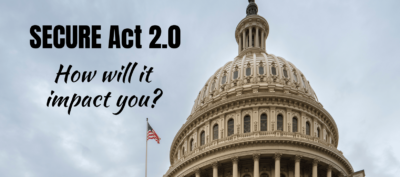The Setting Every Community Up for Retirement Enhancement (SECURE) Act 2.0 was signed into law late in December 2022. SECURE Act 2.0 builds on the original passed in 2019, and it introduces dozens of provisions intended to improve retirement outcomes while also battling inflation. Here are several of the most important measures that could impact you:
Table of Contents
New Ways to Use Your Money
Use of 529 Accounts to Pay Off Student Loans
Under the new law, investors may now withdraw up to $10,000 from 529 education savings plans to repay student loans. This change allows you to use money originally set aside for your kids’ or grandkids’ education, instead of dipping into your savings accounts.
529 Funds can be Transferred to a Roth IRA Account
If you anticipate having money left over in your child’s 529 plan, starting in 2024, you can roll over up to $35,000 of the 529 college funds into a beneficiary’s Roth IRA. The 529 plan must have been in effect for 15 years, and it is subject to both a $35,000 lifetime cap and annual IRA contribution limits, which currently sit at $6,500. While money added within the past five years can’t be used, the bottom line is that we now have more flexibility when there are excess funds in a 529 plan.
New Penalty-Free Withdrawals
Effective towards the end of 2025, employees can withdraw $2,500 annually from their company-sponsored retirement plan to pay for long-term care insurance. This is a tremendous benefit. As we age, more and more of us will encounter a major health event that requires long-term care, such as in-home medical assistance or a nursing facility. Many people forego long-term care insurance because they think it’s too expensive. However, the average cost of a private room in a nursing facility can be upwards of $100k annually, depending on where you live. This new rule makes it more affordable and tax friendly.
And while this from the original 2019 SECURE Act, it is worth repeating: parents may withdraw up to $5,000 from a retirement account for qualified birth or adoption expenses without a 10% early withdrawal penalty. The caveat is that withdrawals must occur within one year of the birth or adoption and you may still owe taxes on the money withdrawn.
QCD Maximums Indexed for Inflation
QCDs were introduced in 2006 to help people aged 70 ½ satisfy their RMDs by making a charitable gift with the money in their IRA account. There are usually tax advantages with making a QCD, instead of taking the RMD as income. Effective in 2024, the new QCD annual limit of $100k is indexed for inflation, which means the annual limit will be adjusted each year.
More Ways to Save for Retirement
Auto-Enrollments in Retirement Plans
Starting in 2025, the SECURE Act 2.0 requires companies offering retirement plans to automatically enroll their employees into retirement accounts such as 401(k) or 403(b) plans. You will have the chance to opt out if you like.
In the first year, your employer will determine how much of your salary they will allow you to put aside for savings. It will be between 3% and 10%. Starting the second year, that number will increase to between 3% and 15%.
The earlier you begin saving, the potential to grow your money for retirement is greater. This might be a good time to look at your own 401(k) savings and consider if you are saving enough. Is that the right place to put your retirement savings? How much does your employer match?
Some business types are exempted from auto-enrollment requirements, and this is something you should discuss with your financial advisor.
Roth Contributions to Retirement Plans
Starting in 2023, employers can make contributions to the Roth side of retirement plans. This provides a great opportunity to build assets that will avoid taxation when withdrawals begin. It is important to note that it is not mandatory or automatic for employers to participate in this option. Offering after-tax contributions to employer-sponsored Roth plans are entirely at their discretion.
Options for Annuities
You can use insurance productions like annuities to turn savings into a lifetime income stream. Companies now have the ability to offer annuities inside of their 401(k) plans. This is significant because one of the hardest parts of retirement income is making your savings last through your lifetime.
Employer-Sponsored Student Loan Payments
Starting in 2024, employers can make matching contributions on behalf of their employees into 401(k)s, 403(b)s, 457(b)s, or SIMPLE IRAs with respect to qualified student loan repayments. Employees can then use those contributions for qualified student loan payments. This is good news for students who want to begin accumulating tax-favored retirement savings.
More Time to Save for Retirement
Changes to RMDs
You can fund qualified accounts (like IRAs) with pre-tax dollars. Because no taxes were paid on those dollars, the government mandates that account owners must start withdrawing qualified funds at a certain age and pay taxes on that income. These withdrawals are called Required Minimum Distributions, or RMDs.
The SECURE Act 2.0 pushes the RMD age out to 73 or 75, depending on what year you were born:
| Birth Year | Secure 2.0 Act Impact |
|---|---|
| Before 1951 | No Change |
| 1951-1959 | RMD age pushed back to 73 |
| 1960 & after | RMD age pusched back to 75 |
Basically, if you are currently subject to and taking RMDs, you must continue your existing schedule. But overall, this change gives your money more time to potentially grow tax-free.
Additionally, the penalty for failing to take your RMD used to result in a 50% penalty. This has been reduced to 25% (with a 3-year lookback), and the penalty is further reduced to only 10% if the error is corrected in a timely fashion.
Spousal Beneficiaries
RMD amounts are based on the life expectancy of the IRA owner. But what happens if they pass away before reaching RMD age?
The SECURE Act 2.0 allows the surviving spouse as a beneficiary to adopt their deceased younger spouse’s RMD schedule, meaning they can delay their RMD withdrawals. This is most helpful if the surviving spouse is older than the deceased spouse since it will delay RMDs from the inherited funds until the deceased spouse would have turned age 73.
Furthermore, if the surviving spouse passes away before starting RMDs, their beneficiaries would still be allowed to stretch the distributions over their lifetime, avoiding the new 10-year rule for disbursements.
No Age Limits for IRA Contributions
Provided you are still earning a paycheck, you can keep investing past age 70½. If you want to work longer and have more opportunities to save, the new legislation gives you the potential for a larger nest egg when you finally retire.
Enhanced Catch-Up Contributions
Starting in 2024, 401(k) and 403(b) catch-ups will automatically adjust for inflation and have four age brackets:
| Birth Year | Secure 2.0 Act Impact |
|---|---|
| 49 or younger | No catch-up |
| 50-59, AND 64+ | $7.5k in 2023 |
| Age 60-63 | > $10k ot 150% of standard catch-up |
The bottom line is that the changes allow participants in IRA, 401(k), 403(b), and Simple Plan to contribute more to their plans each year. If you can keep setting money aside each year, you are able to defer your taxes and grow more savings for your retirement years.
New Time Limits for Inherited Accounts
Prior to 2019, beneficiaries of IRA could stretch out the distributions over their own lifetimes, allowing for longer tax-free growth. The “stretch IRA” ended with the passing of the original SECURE Act. With some exceptions, beneficiaries of IRAs (including Roth IRAs) are required to liquidate those accounts within 10 years. This could have major repercussions for the beneficiary, because when the money is withdrawn, the beneficiary must report those funds as income and pay taxes. If the beneficiaries have college-aged children applying for financial aid, this could also affect their FAFSAs (the student loan application forms).
The lesson from all these changes, particularly the elimination of the stretch IRA, is that incorporating tax planning into your overall financial plan is more important than ever. The government is always looking for ways to increase revenue, and one way to do that is to eliminate tax breaks. Many of us Americans have a lot of money invested in tax-deferred accounts. The problem is, one day the tax bill will come due, and we can’t predict what the tax law will be when it does.
What are your options when the rules are constantly changing? You can…
- Let your financial plan become outdated and risk the consequences, or,
- Educate yourself by working with someone who has expertise in retirement planning.
The provisions in the SECURE Act 2.0 are complex. Successful financial planning requires an in-depth review of these new rules and how they apply to you. We encourage you to have a conversation with your advisor to understand how these changes can impact your unique retirement situation. We can help you make sure you have a strategy in place to succeed in an ever-shifting tax landscape.









































